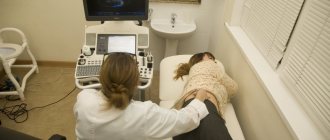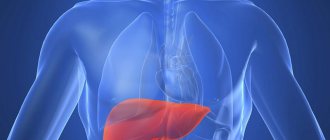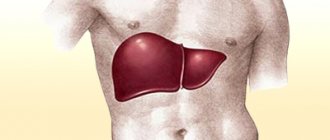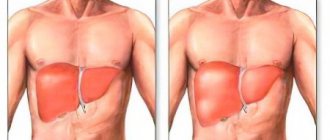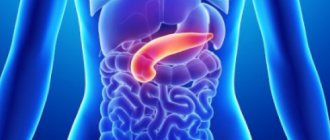A burning sensation in the liver area is a common occurrence that occurs in the elderly, young people and even small children. In this case, discomfort in the right hypochondrium can be a sign of a serious pathology or occurs against the background of physiological processes, which is the norm.
Unpleasant sensations in the projection of the liver are not always provoked by a disease of the gland, but can be associated with other organs. It is impossible to independently understand the causes; a comprehensive examination is required.
Let's consider the possible reasons due to which the liver begins to “burn and burn,” diseases of the gland with symptoms and characteristics of the course.
Pathogenesis
Many people associate pain or burning in the right hypochondrium with liver disease. It is worth remembering that most diseases of this organ, contrary to popular belief, are not accompanied by any pain. The fact is that the liver parenchyma is devoid of pain receptors. However, the capsule, the connective tissue lining of the organ, can hurt. In particular, it is very sensitive to stretching, so if you complain of pain in the right hypochondrium, the doctor may suspect an enlarged liver (when the organ enlarges, it stretches the capsule, resulting in pain). In this case, pain may radiate to the right shoulder and scapula area.
Particularly severe burning pain occurs when sand or stones move through the bile duct. In this case, the pain is paroxysmal, lasting from a couple of minutes to several hours.
For the same reason, pain in the side occurs during unusually strong physical exertion. The fact is that hepatocytes accumulate glycogen, a source of energy. During intense physical activity, the body requires additional energy, so blood flow to the liver is significantly accelerated. This causes an increase in its volume, and as a result - stretching of the capsule and pain in the side.
Often, a burning sensation in the right side is caused by a malfunction of the gallbladder.
Causes of hepatosis in pregnant women
Doctors turned their attention to this disease relatively recently, so experts are still arguing about what causes its appearance. Most medical minds agree that hepatosis in pregnant women is caused by certain genetic characteristics or disorders and can be transmitted through the female line. These genetic abnormalities may not manifest themselves in any way throughout life. But sometimes pregnancy, which brings with it an increase in body weight, hormonal imbalances and an increased load on the body in general and on the liver in particular, gives impetus to the development of hepatosis. The liver is also very susceptible to the influence of pregnancy hormones. For example, estrogen.
The main factors that increase the risk of this disease include:
- Incorrect intake of vitamins. Vitamins are always an additional burden on the liver. Many vitamin complexes contain increased amounts of various components, which cause liver dysfunction, so they need to be taken correctly, taking into account age, body weight, dosage and stage of pregnancy.
- Dietary disorder. Overeating and eating salty, fried, smoked, fatty foods, as well as foods rich in chemical additives, overload the liver and impair its functioning.
- Insufficient physical activity. If the expectant mother moves little, then little energy obtained from food is consumed, and the metabolism, which is already slowed down by pregnancy, slows down.
Take the first step
make an appointment with a doctor!
Associated symptoms
If a burning sensation in the liver is caused by a violation of the structural and functional state of the gallbladder and the liver itself, the patient also notices a number of associated symptoms, including:
- fast fatiguability;
- recurrent headaches;
- poor appetite, and as a result - weight loss;
- insomnia;
- causeless skin itching;
- yellowing of the skin and mucous membranes;
- discoloration of stool;
- darkening of urine.
It is worth noting that liver dysfunction can occur covertly for a long time, without obvious manifestations. Typically, pain and burning appear only in the later stages of the disease.
Types of alcoholic liver damage
Fatty degeneration. At this stage, the process is reversible even without special treatment - just stop drinking alcohol. Steatosis occurs under the influence of ethanol, which disrupts the functioning and structure of hepatocytes. Fat accumulation begins inside them, which displaces the cell nucleus. Gradually the size of the liver increases.
Steatohepatitis. This is hepatitis, caused by regular alcohol consumption and developing against the background of fatty degeneration. When an inflammatory process occurs, hepatocytes continue to increase in size and their structure changes. If the damage is severe, the cells die, and a necrotic process may begin. This affects the structure of the entire organ and disrupts its functions.
Cirrhosis. Fat accumulation continues, fibrous tissue changes appear. The regeneration process is disrupted - attempts at self-healing lead to the formation of tissue nodules. The size of the organ decreases. Fibrous tissue grows, forms wide stripes, and divides the tissue into large nodes.
Order alcoholism treatment
We work around the clock, experienced doctors, 100% anonymous.
The sequential development of these three conditions can lead to death: the liver ceases to perform its functions and the person dies.
The main cause of alcoholic liver damage is regular drinking. The disease can appear even with a small daily dose (from 10 g of pure alcohol, which corresponds to 0.5 liters of beer or 0.2 liters of wine). The process can be accelerated by taking drugs metabolized in the liver, decreased immunity, damage by hepatotropic viruses, malnutrition, and weakened immunity.
Other reasons
It happens that the listed symptoms are not observed, and the clinical picture of the disease is completely different. In this case, other causes of burning, not related to the condition of the liver and gallbladder, should be suspected. Among them, the most common are:
- Intercostal neuralgia is a neurological disease accompanied by periodic paroxysmal pain in a certain area of the chest; An attack can be triggered by coughing or sneezing.
- Osteochondrosis of the intervertebral discs of the lumbar region is accompanied by aching pain in the back, as well as on the right or left side.
- Diseases of the diaphragm - the connective tissue septum that separates the chest from the abdominal cavity. In case of inflammation of the diaphragm, as well as the presence of a hernia, neoplasms, etc. severe pain occurs under the right or left rib (depending on the location of the inflammation).
- Various kidney diseases (for example, pyelonephritis of the right kidney).
- Discomfort in the right hypochondrium is often felt by pregnant women . It must be remembered that the growing fetus displaces the mother’s internal organs, and in the later stages (7-9 months), the mother’s liver is located much higher than usual. Thus, heaviness and burning in the side of a pregnant woman is often associated not with liver disease, but with intestinal dysfunction. Site with moths prostitutes Gelendzhik Intimate leisure
- Burning pain in the lower abdomen is a symptom of appendicitis. Interestingly, when the appendix is inflamed, the pain is first felt in the navel area, and only then “moves” lower and to the right.
- Long-term use of drugs that have a hepatotoxic effect . In particular, the condition of hepatocytes is extremely negatively affected by antipyretic and painkillers (aspirin, analgin, ibuprofen and others), as well as hormonal contraceptive drugs.
Thus, the causes of burning in the right hypochondrium can be very diverse.
Signs of liver problems
We have found out where a person’s liver is located and how it hurts; now we should talk about the symptoms. Liver diseases manifest themselves in different ways. There are external and internal symptoms of liver disease. Let's take a closer look at each group.
External manifestations
- The appearance of spider veins
. Spider veins are a pronounced capillary network of dilated small vessels located in the superficial layers of the skin. This symptom is characteristic of serious liver dysfunction associated with intoxication, viral and alcoholic hepatitis, and cirrhosis. Spider veins most often appear on the lower torso, but sometimes appear on the cheeks and back. - Changes in pigmentation of the skin and mucous membranes
. With liver diseases, regardless of the cause, a person experiences jaundice syndrome. For example, in the acute form of hepatitis, the skin acquires a yellowish tint already 2–3 days after the onset of the disease. The color of the mucous membranes may change even earlier. This occurs due to the fact that the concentration of liver pigment fractions (bilirubin) greatly increases in the blood of an infected person. - Change in color of palms and soles
. A symptom of liver disease is also pronounced pigmentation in places of physiological folds. As a rule, it has a bronze or smoky tint. - Hair loss
. Accelerated hair loss is often observed with liver disease. The liver processes almost all nutrients that enter the body. If liver function suffers, then the body’s supply of “building materials” for growing tissues also suffers. For example, wounds heal more slowly or hair may fall out faster. - The appearance of a rash
. Along with changes in skin color, rashes appear in liver diseases. They can be of a very different nature. Pustular elements (folliculitis and furunculosis) are caused by an immune imbalance due to a decrease in the liver’s ability to synthesize immunoglobulin. An allergic rash (papules and spots) occurs due to a violation of the detoxification function of the liver. This reaction is triggered even to familiar environmental conditions. Hemorrhagic rash (small hemorrhages on the surface of the skin) appears when the synthetic function of the liver decreases. Patients have an increased tendency to form hematomas (“bruises”) even with minor injuries.
Internal manifestations
- Asthenia
. It is characterized by general weakness and lethargy, drowsiness, fatigue, and decreased performance. These symptoms are usually the first to appear when the liver is damaged. Their occurrence is due to the inability of the organ to completely neutralize the products of nitrogen metabolism, which affect the functioning of the brain. - Dyspepsia
. In case of liver diseases, dyspeptic manifestations may be observed in the form of belching, nausea and vomiting, diarrhea or constipation, a feeling of heaviness after eating, and bloating due to increased flatulence. Due to impaired digestion and absorption of fats, qualitative changes in stool occur. Steatorrhea (“fatty stools”) is observed. Any liver disease is usually accompanied by changes in peristalsis (motor activity of the intestines) and the secretion of intestinal glands. - Cytolysis.
The first sign of liver damage is cytolysis—the destruction of hepatocytes. When liver cells (hepatocytes) are destroyed, the level of enzymes such as ALT and AST increases in the blood. If these enzymes are elevated in a biochemical blood test, this indicates an inflammatory process in the liver tissue. - Increased body temperature
. Often, people with constant pain in the liver area experience a slight rise in temperature (up to 37.8 °C). With cirrhosis, thermometer readings can reach 38 °C. In some cases, fluctuations are observed throughout the day, but most often appear in the evening. A higher temperature (from 39 °C) is a symptom of purulent processes in the gallbladder or bile ducts and is not associated with liver disease. Accordingly, treatment is prescribed for another organ.
To learn more about the causes of pain in the liver area and what to do when it occurs, you should consult a specialist. He will conduct an examination, based on which a diagnosis will be made and treatment will be prescribed. In most cases, the main minimum recommendation from doctors is to avoid drinking alcohol and junk food.
Possible diseases
Among the diseases of the liver and gall bladder, accompanied by a burning sensation in the right hypochondrium, the following can be distinguished:
- The presence of sand or stones in the gall bladder is cholelithiasis. Gallstone disease is especially characterized by burning and acute pain in the side. Usually the attack develops suddenly; less often it is preceded by a feeling of nausea, loss of appetite, and a feeling of heaviness in the stomach.
- Chronic hepatitis. Accompanied by periodic burning in the right hypochondrium and epigastrium (the area above the stomach). Associated signs of the disease are weakness, itching, jaundice (not always).
- Parasitic infections. The liver parenchyma can be parasitized by both microscopic organisms (for example, Giardia) and multicellular organisms (for example, flatworms and echinococci). It is worth noting that parasitic liver infections may not be accompanied by pain (if the liver capsule is not affected).
- Neoplasms - cysts and tumors. Neoplasms do not manifest themselves in any way if they are located deep in the parenchyma. A burning sensation in the liver occurs already when the neoplasm has reached a significant size and stretches the capsule area.
- Inflammation of the gallbladder wall (cholecystitis) is also often accompanied by a burning sensation in the right side.
It is almost impossible to find out the cause of a burning sensation in the side on your own; you will need the help of a qualified specialist. The diagnosis is made based on the patient’s complaints, as well as the results of some studies (a general clinical blood test, liver tests, ultrasound, and in rare cases, a biopsy may be required).
Major liver diseases: pathology and distribution
- Hepatitis is liver damage, the appearance of which is triggered by viruses and infections. Experts distinguish several forms of the disease:
- Hepatitis A - occurs due to improper preparation of food or exposure to unsanitary conditions.
- Hepatitis B and C - infection occurs after contact of the body with untreated needles and other medical instruments, as well as during unprotected sex with an infected person.
- Hepatitis D - spreads in the same way as the previous type of disease.
- Hepatitis E occurs after contact with contaminated food or liquid.
- Cirrhosis is a disease whose main cause is considered to be alcoholism. Due to severe poisoning and intoxication, scars form on the liver. Organ tissues begin to harden, and basic functions slow down. The disease is fatal, the damage is irreversible and leads to liver failure.
- Fatty liver disease – cholesterol and triglycerides accumulate in the body. This disrupts the functioning of the organ and causes irreversible pathological processes.
- Autoimmune liver diseases are diseases in which the body independently destroys healthy cells. The immune system protects our body from viruses, bacteria, infections and other malignant microorganisms. In autoimmune diseases, the body begins to attack itself. Damage to healthy liver tissue leads to inflammation and tissue scarring.
Autoimmune organ diseases include:
- Autoimmune hepatitis
- Primary sclerosing cholangitis
- Primary biliary cholangitis
- Genetic lesions of the organ
Some people are predisposed to liver disease. Experts include such ailments as:
- Wilson's disease is an excessive accumulation of copper in the body.
- Hereditary hemochromatosis is excessive accumulation of iron in the body.
- Alpha-antitrypsin deficiency is a disease in which our body is unable to produce sufficient quantities of substances necessary for life.
- Infections that cause liver disorders
Such ailments include:
- Epstein-Barr virus
- Adenovirus
- Toxoplasmosis
- Cytomegalovirus
Treatment
Since burning in the liver area can have various causes, there is no universal treatment that can help everyone. If the burning sensation is unbearable or occurs periodically, consult a doctor. He will find out the causes of the ailment and select the required therapy. So, if viral hepatitis is diagnosed, antiviral drugs are required; if liver parasites are detected, antihelminthics are required; For cholelithiasis, medications that facilitate the flow of bile are indicated.
The goal of treatment is not just to relieve pain, but also to destroy the cause that caused it. In view of this, it becomes clear that taking painkillers has nothing to do with treating the liver. Moreover, taking them can aggravate the patient’s condition, since almost all painkillers have a hepatotoxic effect.
You should not reduce the burning sensation in the right side with anesthetics without first discussing this with your doctor - you can provoke a deterioration in the condition of the liver.
The danger of hepatosis during pregnancy
The affected liver is not able to cleanse the body of harmful substances, which leads to intoxication of the mother and a deterioration in her well-being. Surprisingly, from the very first day after birth, the disease begins to quickly recede and soon leaves no trace behind. After 1-2 weeks, blood counts return to normal. Even if hepatosis recurs in several pregnancies in a row, it does not make any visible changes in the woman’s liver. However, this does not mean that this disease is harmless. It disrupts the metabolism between mother and fetus, thereby adversely affecting the child. It has been proven that hepatosis increases the likelihood of perinatal mortality by 5%, and in 35% of pregnancies occurring against the background of this disease, hypoxia, prematurity and delay in fetal development were observed.
Prevention of hepatosis in pregnant women
Although hepatosis is considered the result of certain genetic characteristics, there are a number of recommendations to avoid it or delay its appearance for a longer period:
- Dieting. If you have a tendency to overload the liver, then you must completely avoid everything fried, fatty, smoked, salty, spicy and sour. The diet should consist of fruits, vegetables (except potatoes, legumes, onions and garlic), low-fat dairy products, chicken breast meat, and low-fat fish. You should not eat chocolate and other cocoa-containing products, egg yolks, cheese, pastries (1-2 pieces of black bread per day are allowed).
- Physical activity. Movement is life, so you need to move more. This speeds up metabolic processes in the body, eliminates congestion, and facilitates the functioning of the liver.
- Refusal of oral hormonal contraceptives and antibacterial agents. They can cause great harm to the liver.
- Take vitamins carefully or avoid them. If possible, you should try to get all the substances the body needs from food, and not from vitamin complexes.
- Treatment of chronic gastrointestinal diseases.
- The use of hepatoprotectors and choleretic drugs. If pregnancy is not planned yet, then it is enough to carry out preventive courses with these drugs, and if pregnancy has already occurred, then they must be taken according to a special schedule agreed with the attending physician.
Hepatosis in pregnant women is a very insidious disease. If you suspect you have signs of it, be sure to tell your doctor so that he can order a blood test and make or rule out a diagnosis.

